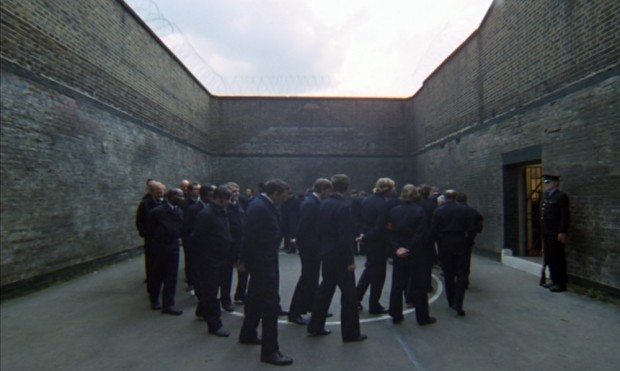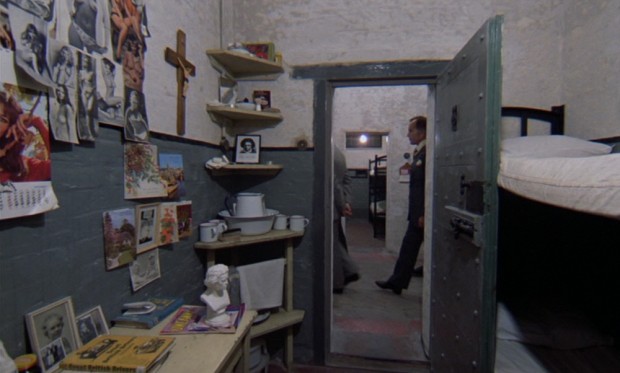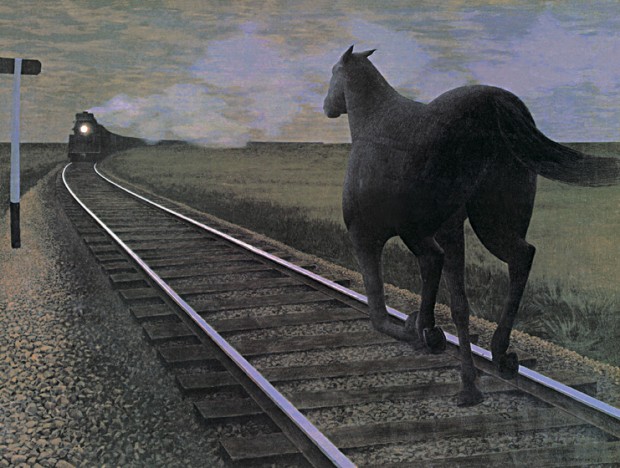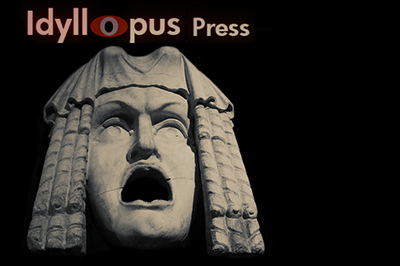
Go to TOC for this film ( (which has also a statement on purpose and manner of analysis and a disclaimer as to caveat emptor and my knowing anything authoritatively, which I do not, but I do try to not know earnestly, with some discretion, and considerable thought).
This post should be read following my one on Rememberance and Repetition in The Shining as well as my notes on Kubrick's use of "Dies Irae" in my comments on the Opening section of The Shining.
The Railroad and A Clockwork Orange
The manner in which A Clockwork Orange is constructed, we have Alex in a series of events which he accidentally revisits after his time in prison and the Ludovico treatment, thus experiencing them again if in a different way.
The section in which Alex is selected for the Ludovico treatment begins with Alex circling in the exercise yard with the other inmates, cuts away to the Minister of the Interior reviewing Alex's cell, and then returns to the prison yard where we have the continuing circulation of the prisoners interrupted by the Minister of the Interior and Alex has his confrontation with him.
We see two publications in Alex's cell during the review. One is a book on British drivers, showing a sports car much like the Durango Alex drives to HOME toward the beginning of the film. The other is this.

Comics.org is the source for the above image.
The comic is Uncanny Tales issue 143, from 1963. The cover shows a photographer's developing tray, and the developing photo of a train running into a wagon on a track. A speech bubble reads, "Holy smoke! I've photographed something that happened a century ago!" This is accompanied by the text, "What amazing power did it have which allowed it to photograph the long dead past? Find out in 'The Strange Old Camera!'" To the side of the developing tray we see also a small bottle of developer--only developer--but it looks much like the vial from which the Serum-114 will be extracted.
The idea that something from the past has been photographed in the present is an example of ideas I've written about concerning ZKR, remembrance, being expressed in not only The Shining but other films of Kubrick's. As I hope to show in this post, we have here not just a phantom event but a form of anamnesis, and ZKR, which can be best represented with the idea of the eucharist and that it becomes the body and flesh rather than only being a metaphor. So it is with ZKR, anamnesis and memory, where we have a thing which is experienced again but is not only a memory, is not simply deja vu, it is a living event, and through the doubling is also subject to change. A Clockwork Orange is all about predestination as versus free will, subjects certainly concerned with anamnesis and whether the re-experiencing of an event must always mean a similar result or if there can be change as brought about by, say, free will. This anamnesis presented on the cover of the comic is a commentary on Alex's condition, and his later being doomed to re-visit the events of the first part of the film, instead experiencing them as the victim.
The Railroad and The Shining
Moving on to The Shining, during the Interview section, we see Wendy eating lunch with Danny, during which we have the sound of a train entering via a cartoon Danny is watching when he is admitting it is hard to make new friends, but that he doesn't want to go to the Overlook. While Wendy is washing dishes after lunch, she receives a phone call from Jack in which she learns he has gotten the job at the Overlook. On the television in the background is a film called Carson City in which a man is hired to build a railroad between Carson City and Virginia City. Bandits, who have been attacking the stage coach, do their best to ensure the railroad doesn't go through. In the portion of the film that is playing when Wendy is talking with Jack, the man who is building the railroad, Silent Jeff, is having a conversation with one of the (unknown to him) saboteurs. The Kubrick Corner states that continuing from the point where we see the movie behind Wendy in the living room, running it in real time, to when the blood is shown gushing through the elevator shaft in Danny's vision, that gushing elevator blood matches up with a discussion in the Carson City film on a leak having been found in the tunnel that's then under construction. Silent Jeff reveals that there is not only one tunnel, but that a second tunnel has also been blasted and wants to check the second tunnel to see if it too is leaking. It's via this second tunnel that trapped workers are rescued when an avalanche covers the entrance to the first tunnel.
After Danny's black-out, as the doctor leaves his room with Wendy, as they go to the apartment's living room we view then the painting of the horse running down the track toward the train.
Though the audience won't know about Carson City, Kubrick has embedded bits of information so that The Shining anticipates and then complements the film on the television as it runs.
An article on Alex Colville, the painter, at Canadianarthistory.wikispaces relates,
The Horse and Train is one of Colville's best known works. Many who critique the painting believe that the painting expresses a source of human nervousness and ask the vital question of most: can destiny be altered? The viewer is a helpless witness of an impending disaster, and will never know the outcome because the painter has not painted it yet.
Again, the concerns of predestination and individual freedom. What do we have occurring while the railroad film is playing in the Torrance's living room? Danny is in the bathroom having his first shining, his first vision of the Overlook, its bloody elevator and the girls. There again enters the question of anamnesis by way of these shinings which instead seem to turn deadly real, no longer just a matter of past events but actually intruding on the daily lives of the Torrances and threatening reoccurence.
In A Clockwork Orange, Alex believes he knows what he's up to when he volunteers for the Ludovico treatment, but he instead seems on a predetermined collision path with destiny. Jack, in The Shining, later relates that when he had entered the Overlook he was already consumed by deja vu. The question is are these individuals being railroaded by the forces of fate.
Later in The Shining the train/horse appears again though not in full. In the Saturday section, before Danny comes upon the girls in the hall, Wendy is shown trying to call out but is unable to because of the snowstorm. On the wall beside her is a horse shoe.
When Danny subsequently sees the girls in the bloody hallway vision of them we see the heel of the shoe that has been perhaps left behind by the murderer. That shoe heel distinctly recalls the horse shoe not only in shape but with its nail holes.

The Railroad and Eyes Wide Shut
Where's the railroad in Eyes Wide Shut? Let's go to the coffee shop where Bill stops after being followed by the bald man. Before entering he purchases a newspaper. Inside, having ordered coffee, he sits and reads.
Our focus is intended to be on an article on Amanda Curran who has overdosed, but we should also look at the articles surrounding the one on Amanda in Bill's "Lucky to Be Alive" newspaper.
One concerns an Anthony Norman who was a robber responsible for a hostage drama on the train.
...train ticket...
...to Norman, two
the robbery fol-
...to the Brentwood
...called police.
...got on the 12 car
...rying 400 passengers
...to the ninth car.
... (?) Jerry
...(?)...
...Manhattan.
...noticed that
...(?) a big
...
...meanwhile, called
...LIRR and ordered that
...(?)...
...in Wyendanch. When
the train arrived, 12 cops
came on the platform with
their guns drawn.
They went through the
train ordering passengers off.
In the ninth (?) car, cops saw a
green jacket with red lining
that matched the description
of the robber's jacket.
...said it wasn't his.
...found a photo
...side the jacket and
...they started going
...it, Norman said,
...
...was over.
...grabbed Maldo-
...around the neck with
...and put the other in
...pretending he had a
...threatened to kill his
...and himself.
...not going down," he
..."You're not going to
...me alive. I'm not afraid
...You're going to have to
...me out of here in a body
...
...Quinlivan, 30, said
...10 to 15 passengers in the
...for cover.
...the floor and so did
...body else," she said.
...when police hostage (?)
...Richard (?) ar-
...Norman agreed to re-
...Maldomado and let the
...leave if the other
...were withdrawn.
...the car cleared. Nor-
...and Sneider spoke for 10
...before Norman sur-
endered. He was charged ini-
...with first-degree rob- ...
The above story in the "Lucky to be Alive" paper is not a fictional event. This indeed happened on December 10, 1996. A man named Anthony Norman, 34, of Brentwood, L.I., took a passenger on the LIRR hostage and threatened to shoot others.
The below article is also in the "Lucky to be Alive" paper. What it's about is how the Norman event called up for people horrifying memories of another hostage situation, three years earlier, in which Colin Ferguson, of Brooklyn, killed 6 people and injured 19 on the LIRR train. The massacre had occurred December 8, 1993 and is what is being referenced in the article on mental violence.
DRAMA...
McCARTHY's PAIN
Long Island Rep. elect
Carolyn McCarthy got
a shocking reminder
yesterday of her own
tragedy--the Long Island
Rail Road massa-
cre three years ago--
when she heard about
the latest terror train
ride.
McCarthy, who at-
tended a memorial
service Saturday for
her husband and the
other passengers killed
in the 1993 massacre,
said it reminded her
once again "just how
fragile we are and how
much violence is with
us."
McCarthy cam-
paigned for Congress
on the issue of gun vio-
lence.
"I don't know what a congressman can do,"
she said. "We have to have no-tolerance for
violence...even this
mental violence."
Another example of a form of anamnesis, at least in Kubrick's terms, if you look back to how the railroad is handled in A Clockwork Orange and The Shining. Much like A Clockwork Orange, Bill's journey in Eyes Wide Shut is divided into two distinct parts. He experiences certain events and then the following day he pursues them again, to find out their truth, thus revisiting the situations, only he does so with intent whereas in A Clockwork Orange Alex accidentally found himself visiting previous situations.
Now, quite frightened, having traversed a maze several times--and unaware of the maze though pursuing his inquiries with intent--Bill has picked up this paper and is sitting in a coffee shop that is actually The Rainbow costume shop. He's reading about Amanda having overdosed, and believes her to be the mysterious woman at the so-called orgy, unaware as yet she was the prostitute who had also overdosed at Victor's party. And surrounding this article on Amanda we have two violent train incidents--one physical, another not progressing past hostage taking and threats of other violence--occurring on about the same date several years apart, which matches well with how the train/rail in The Shining was coincident with Danny shining the past in the present (Dick later referring to these shinings being like aromas lingering from burnt toast which couldn't harm) and the railroad and train in A Clockwork Orange also having to do with past incidents breaking into the present.
Nassau County District Attorney Denis Dillon prosecuted both Colin Ferguson and the "Long Island Lolita" Amy Fisher in 1992. And that coincidence of course brings up Kubrick's film Lolita, in which a girl was taken captive by Humbert Humbert.
Kubrick, no doubt, considering how he had used train imagery in his films, would have been impressed by the synchronicity of Colin Ferguson and the "Long Island Lolita" both being prosecuted by Dennis Dillon, on top of which there was the Anthony Norman event which reminded so many of Colin Ferguson, and was an example in real life of his intended use of the Uncanny comics story. Any wonder the stories made it into Eyes Wide Shut, though essentially buried, yet framing the story of Amanda's second overdose, which Victor would present as fate, saying that even Bill had said it was only a matter of time, when Bill had said nothing to that effect at all.
A Few Other Examples of Repetitions and Recyclings
Kubrick doesn't only use railroad imagery as anamnesis commentary. For example, in Lolita he uses Poe's "Ulalume", but I already write of that in my commentaries on Lolita and A Clockwork Orange and will refrain from going into it here and complexing and perhaps perplexing the waters.
In 2001, these repetitions are instead expressed at the opening with Nietzsche's Eternal Return. Kubrick departs form Nietzsche as he allows for differences to occur in his expressions of repetitions, they are not literal and concrete. Within these recyclings, Kubrick's characters struggle with predestination as versus free will, as some approach a realization of their plight.
2012. Approx 2386 words or 5 single-spaced pages. A 18 minute read at 130 wpm.
Return to the top of the page
Return to Table of Contents for "The Shining" analysis
Link to the main Kubrick page for all the analyses







